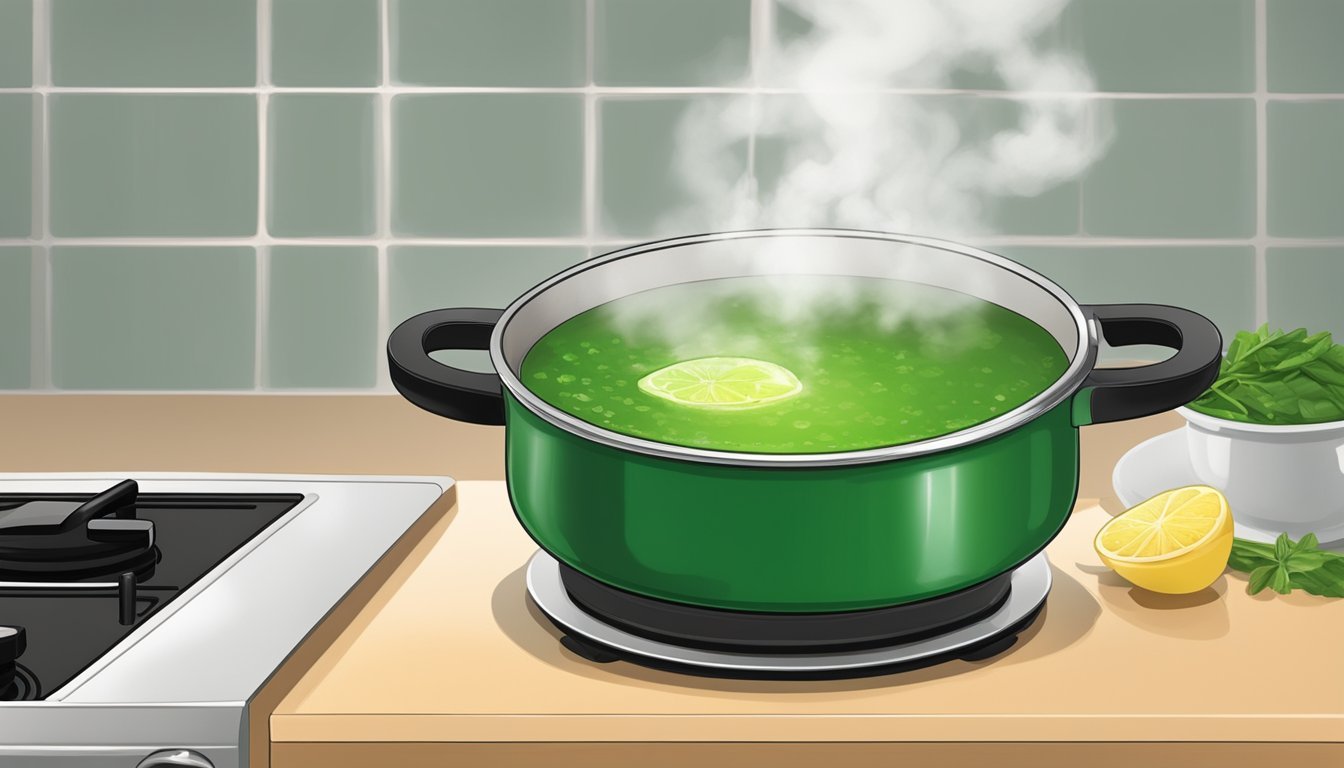How to Reheat Caldo Verde for Optimal Flavor and Texture
Caldo Verde, the traditional Portuguese green soup, is a beloved comfort food that warms hearts and satisfies taste buds. Whether made from scratch or enjoyed as leftovers, the challenge often lies in reheating this national dish of Portugal while maintaining its rich flavors and tender textures. The best way to reheat Caldo Verde is to transfer it to an oven-safe dish, cover it with foil, and heat it in a preheated oven at 350°F for approximately 10-15 minutes.
Balancing the textures and flavors of Caldo Verde involves several steps. When reheating, it's important to keep the broth's rich, olive oil-enhanced flavor intact and ensure that the greens remain tender. Heating in an oven rather than a microwave helps achieve this balance, preventing the soup from becoming overcooked.
Understanding the specific ingredients in each recipe can guide the reheating process. Caldo Verde typically includes potatoes, collard greens or kale, and a type of sausage like chorizo. By following these methods, one can enjoy this comforting green soup with all its traditional flavors preserved.
Understanding Caldo Verde
Caldo Verde is a traditional Portuguese soup known for its comforting blend of ingredients. It combines the hearty flavors of sausage, potatoes, and kale, all simmered in a savory broth. This soup is not only a staple in Portuguese cuisine but also offers nutritional benefits.
Historical Background
Originating from the Minho region in northern Portugal, Caldo Verde has a rich history. This iconic dish was traditionally served at celebrations and gatherings, symbolizing warmth and comfort. Over time, it spread across the country and became popular in Portuguese communities worldwide. The simplicity and accessibility of its ingredients contributed to its widespread appeal.
Key Ingredients
Sausage: Typically, chouriço or linguiça is used, adding a smoky, savory flavor.
Potatoes: These provide a creamy base, making the soup hearty.
Kale/Collard Greens: Shredded greens add texture and nutritional value.
Olive Oil: Enhances the flavor and richness of the broth.
Broth: A flavorful stock that ties all the ingredients together.
Each component contributes to the dish's unique taste and consistency, making it a beloved staple in Portuguese cuisine.
Nutritional Information
Caldo Verde is not only delicious but also nutritious. A typical serving contains around 200-300 calories, depending on the portion size and specific recipe variations. It is rich in carbohydrates from potatoes, providing energy. The greens add valuable fiber, which aids digestion.
Calories: Approximately 200-300 per serving
Carbohydrates: Mainly from potatoes, offering energy
Fiber: From greens, beneficial for digestion
Protein: Provided by the sausage, contributing to muscle maintenance
Additionally, the soup contains vitamins and minerals from the kale and healthy fats from the olive oil, making it a balanced meal.
Preparation Basics
Understanding the foundational steps in making Caldo Verde sets the stage for a perfect reheating process. This includes selecting fresh ingredients, following initial cooking steps, and creating a flavorful broth.
Selecting Ingredients
Choosing the right ingredients is crucial for an authentic Caldo Verde. Yukon Gold potatoes are preferred for their creamy texture, though russet potatoes can also work. The greens, traditionally kale or collard greens, should be fresh and vibrant.
Chouriço (Portuguese sausage) adds a smoky flavor to the soup. For a vegetarian or vegan option, this can be omitted or replaced with a plant-based sausage. Other essentials include onion, garlic, olive oil, salt, pepper, and broth or water. Ensure all ingredients are gluten-free and dairy-free if required.
Initial Cooking Steps
Begin by cooking the sausage in a Dutch oven or heavy soup pot until it’s slightly browned. Remove and set aside. Use the rendered fat to sauté onions and garlic until they are soft and fragrant.
Add diced potatoes and your choice of liquid — either water, vegetable, or chicken broth. Bring to a boil over high heat, then reduce to a gentle simmer. Cook until the potatoes are tender, typically about 20-25 minutes. This step creates a rich base, enhanced by the flavors absorbed from the sausage fat.
Creating the Broth
After the potatoes are soft, remove the pot from heat. Using an immersion blender, puree the potatoes within the pot to create a smooth, creamy consistency. Alternatively, a regular blender can be used, but take care with hot liquids.
Return the pot to medium heat and add chopped greens. Typically, about one bunch of kale or collard greens is sufficient. Season with salt and pepper. Add more water or broth as needed to achieve the desired consistency. Stir well and bring to a gentle boil, ensuring the greens are cooked but still tender. This final step results in a rich, flavorful Caldo Verde base, ready for serving or reheating.
Proper Storage Techniques
Proper storage of Caldo Verde ensures that its flavors remain intact and that reheating is straightforward. Key methods involve refrigeration and freezing, each with specific guidelines to maximize quality and safety.
Refrigeration Tips
To store Caldo Verde in the fridge, first allow it to cool completely. Use a sealed container to maintain moisture and prevent the soup from absorbing other flavors in the fridge. You can store Caldo Verde in the refrigerator for up to 4 days without compromising its taste or texture.
It is essential to label the container with the date of preparation to track freshness. When it's time for reheating, transfer the soup to a saucepan and warm over medium-low heat until thoroughly heated. Stir occasionally to ensure even heating and avoid overcooking the greens, which should remain tender.
Freezing Instructions
If you plan to store Caldo Verde for an extended period, freezing is an effective method. Once the soup has cooled fully, portion it into containers or resealable bags to allow easy thawing and reheating later. Caldo Verde can be stored in the freezer for up to 3 months.
Before reheating, thaw the soup in the refrigerator for several hours or overnight. This gradual thawing process helps maintain the soup's texture and flavor. To reheat, transfer the thawed soup to a saucepan and warm over medium heat. Stir occasionally, ensuring the soup is heated through without losing its rich taste.
Proper storage ensures your Caldo Verde remains a delicious, convenient meal option.
Reheating Methods
When reheating Caldo Verde, maintaining the dish's texture and flavor is essential. The methods described here will guide you in achieving a delicious and evenly heated soup while preserving its signature components.
Stovetop Reheating
Using the stovetop is a quick and effective way to reheat Caldo Verde. Place the soup in a saucepan or pot and set the heat to medium. Stir occasionally to ensure even heating.
Allow the soup to simmer gently rather than boiling. This helps maintain the tender texture of the greens and prevents the potatoes from becoming mushy. The simmering process usually takes about 10-15 minutes.
If needed, add a small amount of water or stock to keep the broth at the desired consistency. Using a lid on the pot can also help retain moisture and heat more evenly. Be vigilant to avoid overcooking the sausage, as it can become tough.
Oven Warming Technique
Preheating the oven to 350°F (175°C) is the first step in this method. Transfer the Caldo Verde to an oven-safe dish and cover it with foil to trap moisture and heat.
Place the dish in the oven and allow it to warm for approximately 10-15 minutes. Check periodically to ensure the soup is heating evenly. The goal is to have the broth heated through, while the flavor is preserved without losing the richness from the olive oil.
Using the oven is especially useful when you want to reheat a larger quantity of soup without constant monitoring. Key factors, such as using a covered dish, help significantly in maintaining the soup's desired texture.
Serving Suggestions
Serving Caldo Verde can be enhanced by thoughtful accompaniments and presentation tips that emphasize its rich flavors and fresh ingredients.
Accompaniments
Caldo Verde pairs excellently with bread options such as broa (Portuguese cornbread) or crusty artisan bread. The dense texture and mild sweetness of broa complement the soup's robust flavor.
A drizzle of extra-virgin olive oil on top of the soup before serving amplifies its richness. Sliced linguiça or chouriço, served alongside the soup, adds a smoky, spicy note.
For a lighter touch, accompany the soup with a simple green salad dressed with olive oil and vinegar. It provides a refreshing contrast and balances the richness of the main dish.
Presentation Tips
Serve Caldo Verde in white bowls to highlight its vibrant green color. Garnish each bowl with a drizzle of extra-virgin olive oil and a few slices of linguiça or chouriço for visual appeal and added flavor.
Arrange crusty bread slices or broa on a small plate next to the bowl, making it easy for diners to enjoy both elements together.
If using appetizers, place them on a shared platter in the center of the table to create a communal, inviting atmosphere. The key is to emphasize the soup's fresh ingredients and rich, comforting taste through thoughtful presentation.
Variations of Caldo Verde
Caldo Verde, a beloved Portuguese kale soup, showcases numerous variations influenced by regional traditions, dietary choices, and contemporary culinary trends.
Regional Twists
In different regions of Portugal, Caldo Verde may feature ingredients that reflect local flavors. The traditional Portuguese chouriço is often replaced with local sausages.
In the north, linguiça is common, adding a distinct smoky flavor. Some variations include Spanish chorizo, incorporating a hint of smoked paprika and red pepper flakes, adding a subtle heat. Potatoes remain a staple, but certain regions may also add white beans to enhance the soup's texture and nutritional value.
Vegetarian and Vegan Adaptations
For those preferring plant-based diets, Caldo Verde can be easily adapted to exclude meat. Collard greens or kale are still used, retaining the soup's signature green color.
Instead of sausage, smoked paprika and red pepper flakes offer a depth of flavor. Beans, such as white beans, are added for protein and heartiness. Vegetable broth replaces chicken stock, ensuring the soup remains rich and satisfying without animal products.
Contemporary Variations
Modern twists on Caldo Verde reflect global culinary influences and innovative cooking techniques. While traditional recipes emphasize simplicity, modern versions might incorporate additional vegetables like carrots or bell peppers for more color and sweetness.
Chefs may use smoked sausage instead of traditional varieties to introduce a new dimension of flavor. Chorizo and the addition of spices like cumin or coriander are also popular, providing a fresh and exciting take on this classic dish.
By adapting Caldo Verde to suit different tastes and dietary preferences, this traditional soup continues to evolve while maintaining its roots in Portuguese cuisine.
Tips and Tricks
Maximizing the flavor and texture when reheating Caldo Verde is crucial to maintaining its deliciousness. Utilizing the right techniques and ingredients ensures a well-balanced and enjoyable dish.
Enhancing Flavor
To bring out the rich flavors, consider adding a bit more salt and pepper during reheating. This helps intensify the taste. If the soup seems a bit flat, a splash of chicken broth or chicken stock can add depth.
For an extra kick, sauté some garlic cloves in oil before adding them to the soup. This infuses the broth with a more robust aroma.
If the soup was initially made with simple ingredients, enhancing it with a drizzle of fresh olive oil at the end can elevate the flavor profile remarkably. Don't hesitate to adjust seasoning levels to maintain the soup's rich and comforting essence.
Improving Texture
Ensuring the right texture involves gentle reheating techniques to avoid overcooking. Preheat the oven to 350°F, transfer the soup to an oven-safe dish, and cover it with foil to retain moisture. Heat for 10-15 minutes.
To maintain the desired creaminess, re-purée half of the soup using a blender before reheating. This preserves the smooth consistency if it has thickened too much.
Avoid boiling the soup as this can make the potatoes and other vegetables mushy. Instead, simmer on a low heat until warmed through. For greens like kale, ensure they remain tender by minimizing reheating time to prevent them from getting too soft.
By following these steps, you'll ensure your reheated Caldo Verde remains as delightful as the first serving.
The Significance of Caldo Verde
Caldo Verde, a traditional Portuguese soup, holds deep cultural and social importance in Portugal. Often recognized as a national dish, this green broth is both hearty and nutritious, making it a staple in various celebrations and occasions.
Cultural Importance
Caldo Verde is a symbol of Portuguese culinary heritage. It is a simple yet flavorful soup made primarily from potatoes, shredded kale, and chorizo. The ingredients reflect the country's agricultural resources and emphasize rustic, home-style cooking.
Seen as more than just food, Caldo Verde embodies family and community values. Shared at family gatherings, it fosters a sense of togetherness. Often cooked in large quantities, it is meant to be enjoyed by many, reinforcing communal bonds.
The soup is also recognized for its nutritional benefits. The kale provides essential vitamins, while the potatoes and chorizo add hearty sustenance, creating a balanced meal. This nutritional value contributes to its longstanding place in Portuguese cuisine.
Occasions and Celebrations
Caldo Verde is a fixture at festive events and special occasions in Portugal. It is especially prevalent at weddings, birthdays, and national celebrations, often served as a midnight snack to keep guests warm and satisfied.
During St. John’s Festival (Festa de São João), one of Portugal's most popular celebrations, Caldo Verde is traditionally consumed. The festival, marked by music and dancing, features this soup as a culinary highlight, underscoring its significance in Portuguese culture.
On Christmas Eve, Caldo Verde is often part of the meal, symbolizing comfort and warmth during the holiday season. Its presence in diverse celebrations highlights its versatile role in Portuguese life, from casual family meals to major cultural events.







